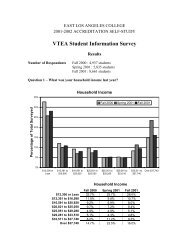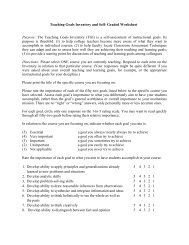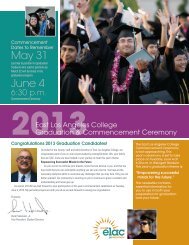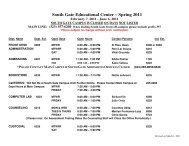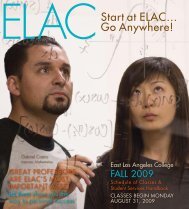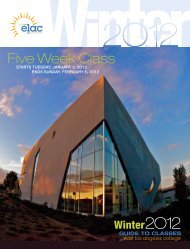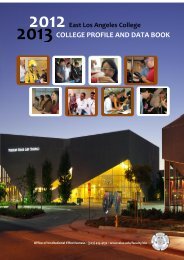ELAC Educational Master Plan - East Los Angeles College
ELAC Educational Master Plan - East Los Angeles College
ELAC Educational Master Plan - East Los Angeles College
You also want an ePaper? Increase the reach of your titles
YUMPU automatically turns print PDFs into web optimized ePapers that Google loves.
36%. There appears to be no difference in the rate at which students delay taking the next course in the<br />
sequence based on their previous grade. Although there have been suggestions that students delay taking<br />
courses in their sequence, it appears that a large majority of students are entering directly into the next<br />
course in the sequence without delay. The data suggests that delaying taking the next course in the<br />
sequence lowers the success rate in the next course dramatically. This impact occurs regardless of the<br />
grade in the previous course.<br />
Grade in<br />
Math 115<br />
Took Math 125 Next<br />
Semester (N = 1554)<br />
Subsequent Success by Grade: Math 115<br />
Took Math 125 Two<br />
Semesters Later (N = 223)<br />
Took Math 125 Three or<br />
Four Semesters Later<br />
(N = 66)<br />
Retention Success Retention Success Retention Success<br />
A 92.9% 82.8% 85.1% 63.8% 77.8% 55.6%<br />
B 79.6% 53.9% 80.0% 35.7% 57.9% 26.3%<br />
C 72.8% 38.4% 64.2% 26.4% 65.5% 13.8%<br />
Total 80.1% 54.6% 73.5% 37.2% 66.7% 28.8%<br />
The majority of students who passed English 26/57 attempted English 28 in the next semester (79.5%).<br />
Students who received an A in English 26/57 were slightly more likely to take English 28 the next<br />
semester compared to students who received a B or C in English 26/57. Very few students waited three or<br />
four semesters to attempt English 28. Overall, both success and retention rates in English 28 showed a<br />
positive approximately linear relationship to grades in English 26/57 (e.g., students who received an A in<br />
English 26/57 had a higher success rate in English 28 than students who received a B in English 26/57).<br />
Also, students who waited two or more semesters to attempt English 28 had lower success and retention<br />
rates than those who took English 28 the next semester. This effect was most evident in students who<br />
received a B or a C in English 26/57. There is a somewhat strange pattern for students who got an A in<br />
English 26/57 and waited two or more semesters to take English 28. Their English 28 success rates were<br />
86.5%, 75%, and 90%, if they took English 28 the next semester, two semesters later, or three to four<br />
semesters later, respectively. This may be due to two reasons. First, there was a smaller sample size of<br />
students who received an A in English 26/57 compared to those who received a B or C. Second, the vast<br />
majority of students who got A’s in English 26/57 took English 28 the next semester. So, the number of A<br />
students who waited two or more semesters to take English 28 may have been too small to accurately<br />
measure retention and success rates.<br />
English 26/57<br />
Grade<br />
Subsequent Success by Grade: English 26/57<br />
Took English 28 Next<br />
Took English 28<br />
Semester Two Semesters Later<br />
(N = 952)<br />
(N = 171)<br />
Took English 28 Three or<br />
Four Semesters Later<br />
(N = 74)<br />
Retention Success Retention Success Retention Success<br />
A 94.5% 86.5% 87.5% 75.0% 90.0% 90.0%<br />
B 89.8% 74.0% 88.6% 68.6% 87.1% 51.6%<br />
C 82.5% 61.1% 79.2% 58.4% 75.8% 57.6%<br />
Total 87.4% 70.5% 84.2% 64.9% 82.4% 59.5%<br />
14 Page <strong>Educational</strong> <strong>Master</strong> <strong>Plan</strong> 2012





